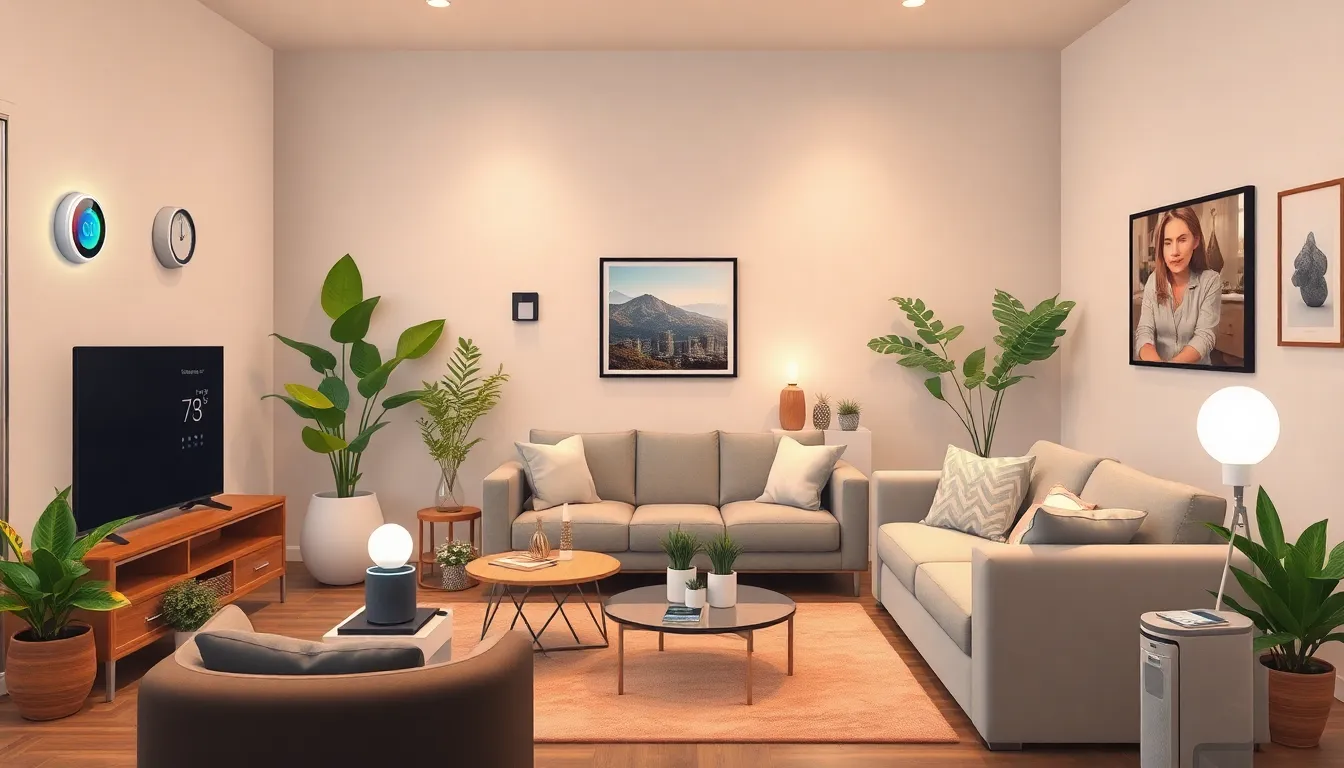Table of Contents
ToggleIn a world where your coffee maker can chat with your toaster, smart home devices have transformed everyday living into a futuristic dream. Imagine waking up to the smell of freshly brewed coffee while your lights gently brighten to mimic the sunrise. Sounds like magic, right? Well, it’s just technology flexing its muscles.
Overview of Smart Home Devices
Smart home devices enhance convenience and efficiency in daily life. Appliances streamline tasks by connecting to the internet, allowing users to control them remotely. Voice-activated assistants, like Amazon Alexa and Google Assistant, act as central hubs for managing various devices. Smart lighting systems enable users to adjust brightness and color with simple voice commands or smartphone apps.
Security systems have evolved significantly. Smart cameras and video doorbells provide real-time monitoring and notifications, ensuring peace of mind. Sensors can detect motion, while smart locks allow keyless entry, increasing overall home security.
Energy efficiency remains a key benefit of smart home technology. Smart thermostats learn user preferences, optimizing energy usage and saving on utility bills. Devices such as smart plugs often allow users to set schedules, turning devices on and off as needed.
Innovative products in home automation offer seamless integration. Smart refrigerators provide information on food inventory and can suggest recipes based on available ingredients. The capability to control appliances and systems from anywhere creates an unmatched level of comfort.
The variety of smart home devices continues to grow. Smart speakers, smart TVs, and appliances integrate seamlessly into homes, creating interconnected environments. Overall, these advancements significantly improve the quality of life for many individuals.
Key Features to Consider

When choosing smart home devices, several key features play a significant role in ensuring compatibility, usability, and security.
Compatibility
Compatibility impacts how well devices integrate into an existing ecosystem. It’s essential to verify that new devices can connect with current home assistants like Amazon Alexa or Google Assistant. Checking for compatibility with various platforms prevents future connectivity issues. Different ecosystems, such as Apple HomeKit or Samsung SmartThings, provide additional integration options. Device manufacturers often specify compatibility details, making it easier to choose devices that work seamlessly together.
User-Friendly Interfaces
User-friendly interfaces enhance the overall experience with smart home devices. Intuitive apps simplify device control and management, ensuring all users can navigate settings easily. Voice commands offer another layer of accessibility, allowing users to operate devices hands-free. Clear setups and straightforward instructions help minimize frustration during installation. Customization options enable users to tailor experiences to personal preferences, increasing satisfaction and engagement.
Security Features
Security features are paramount in protecting a smart home. Strong encryption helps safeguard data transmitted between devices and users. Multifactor authentication adds an essential layer of security, requiring multiple verification steps for access. Real-time alerts notify users of unusual activity, providing peace of mind. Regular firmware updates strengthen security protocols, addressing potential vulnerabilities proactively. Smart home devices should also incorporate user privacy settings, allowing individuals to control data sharing preferences.
Top Categories of Smart Home Devices
Smart home devices enhance daily life through automation and connectivity. Various categories exist, each with unique features and benefits.
Smart Speakers
Smart speakers integrate seamlessly with other smart devices, serving as voice-activated control hubs. Amazon Echo and Google Nest are popular examples that allow users to play music, control home devices, and access information. Voice assistants like Alexa and Google Assistant enable users to communicate easily with connected products, enhancing overall convenience. Multi-room audio capabilities let individuals enjoy music throughout their homes. Smart speakers also facilitate hands-free calling and messaging, making daily tasks even simpler.
Smart Lighting
Smart lighting systems offer customizable brightness and colors to create the perfect ambiance for any occasion. Philips Hue and LIFX provide users with the ability to control lights remotely via smartphone apps or voice commands. Scheduling options allow individuals to automate lighting based on their routines, which can enhance security when away from home. Energy-efficient LED technology reduces electricity consumption while producing vivid colors. Integration with other smart devices creates synchronized lighting effects, elevating the overall smart home experience.
Smart Thermostats
Smart thermostats improve energy efficiency through advanced temperature control and scheduling features. Nest and Ecobee are well-known examples that learn user preferences over time, optimizing heating and cooling accordingly. Remote access through mobile apps enables users to make adjustments from anywhere. Features like geofencing adjust settings based on users’ locations, contributing to energy savings. These devices help reduce utility bills while providing a comfortable living environment.
Smart Security Systems
Smart security systems enhance home safety with advanced monitoring and control. Devices like Ring and Arlo offer real-time video surveillance, alerting homeowners of any unusual activity. Smart locks permit keyless entry, enhancing convenience for residents and guests. Many systems include motion detectors and door/window sensors that provide additional layers of security. Integration with smart speakers allows for voice-activated monitoring and notifications, giving users peace of mind whether they are home or away.
In-Depth Reviews of Best Smart Home Devices
This section provides a detailed look at some of the top smart home devices, emphasizing their unique features and benefits.
Device 1: Features and Benefits
Amazon Echo stands out as a versatile smart speaker. This device integrates seamlessly with various smart home systems, allowing users to control lights and thermostats through voice commands. Operating with Amazon Alexa provides hands-free convenience, making it easy to manage multiple devices. Music playback, weather updates, and setting reminders add to its functionality, enhancing daily routines. The device’s ability to create routines enables users to automate tasks, improving home efficiency. Additionally, Echo’s compatibility with various third-party devices broadens its utility in smart homes.
Device 2: Features and Benefits
Nest Learning Thermostat excels in energy management. It optimizes heating and cooling based on user habits, offering energy savings of up to 15% annually. Users can adjust settings remotely via a mobile app, ensuring maximum comfort on the go. This thermostat learns preferences over time, automatically adjusting to preferred temperatures. Easy installation and sleek design enhance its appeal. Furthermore, it provides energy reports, helping users track usage and make informed decisions about consumption.
Device 3: Features and Benefits
Ring Video Doorbell enhances home security significantly. This device captures high-definition video and provides real-time notifications through a mobile app. Users can see and speak to visitors remotely, adding a layer of safety. The night vision feature allows for clear monitoring even in low-light conditions. Easy installation promotes quick setup, while customizable motion detection zones help reduce false alerts. Integration with smart locks offers a comprehensive security solution, ensuring peace of mind for homeowners.
Future Trends in Smart Home Technology
Advancements in artificial intelligence drive the evolution of smart home devices. Increased integration of AI leads to more intuitive systems that learn user behaviors and preferences. Sensor technology is advancing, allowing devices to communicate more efficiently and automate responses based on real-time data.
Home security systems are becoming more sophisticated, featuring AI-powered analytics for threat detection. Enhanced video recognition capabilities improve the functionality of smart cameras and doorbells, providing users with instant alerts about unusual activity.
Another trend is the shift toward energy-efficient appliances. Smart devices now monitor energy consumption more accurately, optimizing usage patterns to reduce costs and environmental impact. Users benefit from the convenience of controlling these appliances remotely, ensuring efficiency even when away from home.
Interoperability among devices is gaining importance. Manufacturers are focusing on creating ecosystems that allow seamless communication between different brands and platforms. Enhanced compatibility ensures that users can manage all their smart home devices through a single application or interface.
Voice recognition is also evolving, becoming more adaptive. Virtual assistants are now capable of handling complex requests and multi-device control, lowering the barriers to using smart technology. Enhanced contextual understanding allows these assistants to deliver personalized responses.
Finally, the rise of voice-activated monitoring systems enhances user engagement. Homeowners can now check on their properties or manage appliances simply by speaking commands, reinforcing the appeal of smart home technology. As these trends continue to develop, the future of smart homes looks increasingly interconnected, user-friendly, and efficient.
Smart home devices are revolutionizing daily living by enhancing convenience and efficiency. With the ability to control appliances remotely and automate tasks, these devices create a more comfortable environment.
The integration of voice-activated assistants and advanced security systems ensures that homes are not only smarter but also safer. As technology continues to evolve, future innovations promise even greater interconnectivity and energy efficiency.
Choosing the right devices based on compatibility and user-friendly features can significantly improve the smart home experience. Embracing these advancements allows individuals to enjoy a modern lifestyle while optimizing their home environment.







